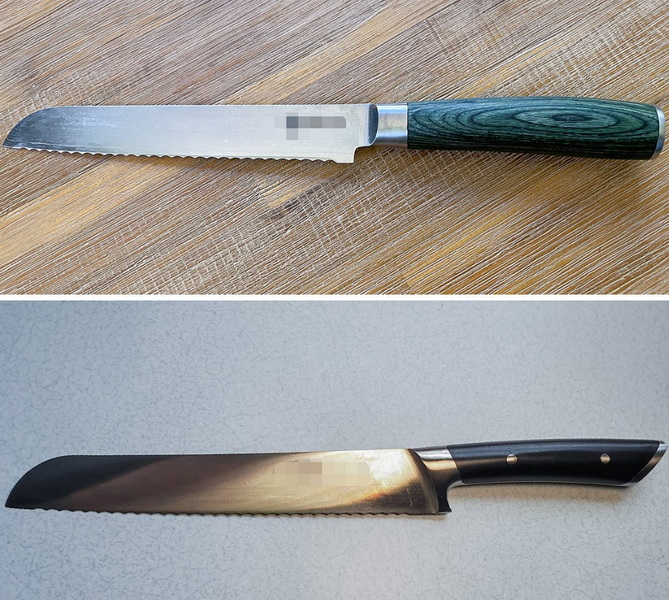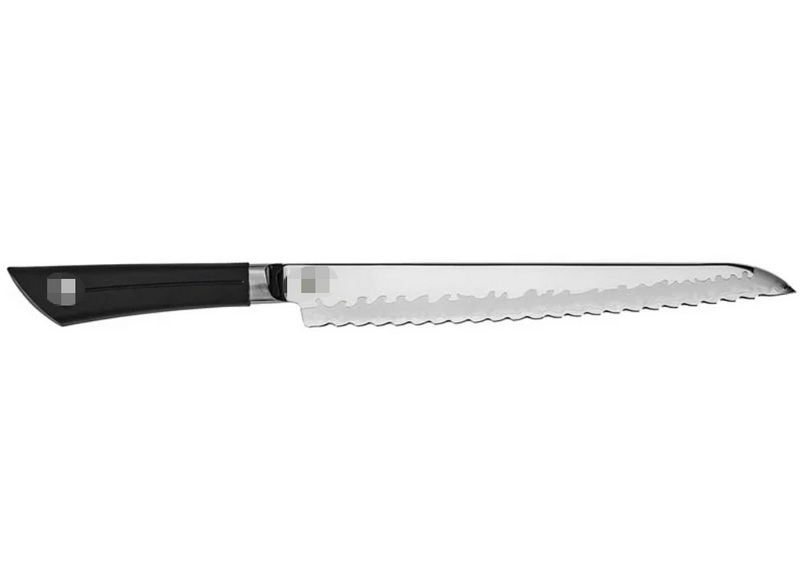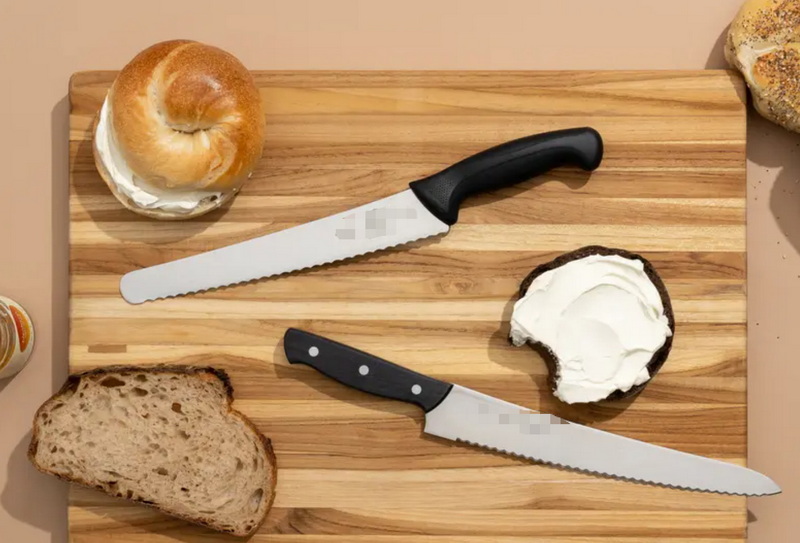- All
- Product Name
- Product Keyword
- Product Model
- Product Summary
- Product Description
- Multi Field Search
Views: 222 Author: Ann Publish Time: 2025-11-06 Origin: Site











Content Menu
● What makes a great budget bread knife
● Design considerations for OEM partners
● Material science insights for bread knives
● Manufacturing and quality assurance (QA) for budget lines
● Key features to highlight for buyers
● Practical care and maintenance guidance
● Global market considerations
● Quality assurance case studies and benchmarks
● FAQs
>> What blade length is typically best for budget Bread Knife?
>> Can a budget Bread Knife be sharpened at home without damaging the serrations?
>> How durable is a budget Bread Knife when cutting hard crusts like sourdough?
>> Which blade materials are commonly used in budget Bread Knives, and what are their pros/cons?
>> How does packaging and branding influence buyer perception for OEM Bread Knives?
Bread knives are indispensable tools in any kitchen, and for international brands, wholesalers, and manufacturers seeking dependable performance without a premium price, a well-chosen budget bread knife can be a decisive selling point. This article delves into how to select and optimize budget bread knives that deliver clean, precise slices through a wide range of loaf textures, while meeting stringent OEM quality standards. We explore blade materials, serration design, handle ergonomics, maintenance tips, packaging and marketing considerations, and how to position value to global buyers.

A budget bread knife should strike a balance between performance, durability, and cost. Several core attributes determine value:
- Blade geometry and serration: A carefully engineered serration pattern and a slightly wider blade help reduce tearing and crumb damage across crusty artisanal breads and softer sandwich loaves. The tooth count, tooth shape, and blade thickness influence edge retention and cutting feel. For OEM programs, standardizing a serration profile across multiple blade lengths can streamline production while preserving performance.
- Material and heat treatment: Budget options often use high-quality stainless steel or high-carbon stainless steel with appropriate hardness to deliver reliable edge life without the premium costs of exotic alloys. A corrosion-resistant composition is critical for kitchen environments and for longevity in international markets where dishwashers and varying cleaning practices are common. Consistent heat treatment ensures stable hardness and toughness across batches.
- Handle comfort and balance: Ergonomic handles that fit the hand securely reduce fatigue and improve control during extended use. For OEM offerings, selecting durable, affordable handle materials with subtle texturing or soft-touch overlays can provide a premium feel without increasing costs. Proper balance between blade and handle enhances slicing precision, especially when working with dense or crusty bread.
- Construction and finish: A robust full tang, secure rivets, and well-finished transitions between blade and handle communicate durability and quality. A uniform finish on the blade, with careful edge rounding and deburring, reduces snagging while disclosing a professional manufacturing standard to buyers.
- Standardization and modularity: Establish a core blade length range (for example, 8–10 inches) and a shared serration profile to enable scalable production across multiple client brands. This reduces tooling complexity, simplifies quality control, and accelerates time-to-market for new accounts.
- Customizable yet cost-conscious options: Offer features that differentiate brands without destabilizing cost structures, such as logo engraving, color-accented handle spacers, or branded packaging variants. Maintain the same blade geometry to preserve performance consistency.
- Packaging and marketing alignment: Provide ready-to-use product visuals, including high-resolution images and short videos demonstrating crust-cutting performance. Clear, professional visuals support international marketing efforts and help reduce buyer hesitations during cross-border sales.
- Documentation and compliance: Prepare multilingual care guides, warranty statements, and usage tips to ease regulatory and customer support processes in diverse markets. High-quality documentation reduces post-sale friction and boosts buyer confidence in OEM engagements.
- Serration mechanics: Serrated edges cut bread by repeating micro-sawing motions that fracture crumb without crushing it. Properly designed serrations maintain bite over time and guide users toward consistent results even as blade wear occurs.
- Steel choices for cost and performance: Mid-range stainless steels balance hardness, toughness, and rust resistance, making them suitable for budget lines. Some OEMs apply protective coatings or passivation to enhance corrosion resistance without incurring heavy costs, which can be a selling point in markets with aggressive cleaning regimes.
- Durability across bread varieties: A bread knife should slice crusts cleanly on a variety of breads—from crusty sourdough and baguettes to softer sandwich loaves. A well-considered blade width and stiffness distribution helps prevent tearing and crumb damage, ensuring reliable performance across formats.
- Material selection and verification: Implement strict supplier qualification for blade steel and handle materials, followed by incoming quality checks to verify composition and mechanical properties. Regular sampling and hardness testing help maintain target performance across batches.
- Precision machining and finishing: Use controlled grinding and deburring processes to achieve consistent edge geometry and smooth handle junctions. Attention to finish quality in the transition area communicates reliability to buyers and reduces customer complaints.
- Serration production control: Calibrate serration tooling and inspection procedures to ensure tooth geometry remains within tolerance across the production run. Periodic re-sharpening or replacement of tooling minimizes performance drift.
- Ergonomic assembly and inspection: Rivet alignment, tang fit, and handle texture should be uniform across all units. QA checks for sharp edges and surface defects protect user safety and product credibility in international markets.
- Packaging, labeling, and documentation: Durable packaging that protects blades during transit, along with clear user instructions and care guidelines, supports a smooth cross-border experience and lowers return rates. Multilingual labeling is often a prerequisite for global distribution.
- Bread-cutting performance: Demonstrable, repeatable results when slicing a variety of bread types, with an emphasis on clean cuts and minimal crumb damage. Buyers respond well to demonstrations and before/after visuals that prove performance.
- Edge reliability and maintenance: Communicate how the blade maintains functionality over time with standard care, including advice on washing, drying, and storage. For serrated blades, emphasize that periodic professional sharpening can refresh performance without altering serration geometry.
- Ergonomics and daily usability: Emphasize handle comfort, balance, and grip texture as differentiators from lower-cost competitors. These factors influence long-term satisfaction and brand perception in international markets.
- Value proposition and after-sales support: Consider offering a limited warranty or maintenance program (e.g., free sharpening within a defined period) to reassure buyers that performance remains strong over time. Clear service terms improve trust in OEM partnerships.

- Cleaning and drying: Hand wash with mild detergent, dry immediately, and avoid dishwasher exposure to preserve edge integrity and handle finish.
- Sharpening and rejuvenation: Serrated bread knives benefit from periodic professional sharpening to refresh performance without compromising serration geometry. Provide guidance on recommended service intervals based on use.
- Storage and organization: Store in a dedicated knife block or magnetic strip to protect the blade tips and serrations. Use blade guards for added protection during transport in OEM shipments.
- North America and Europe: Buyers value solid value-to-performance, brand reliability, and robust after-sales support. A budget bread knife with clear care guidance, reliable packaging, and a reasonable warranty performs well in these regions.
- Asia, Middle East, and other regions: Emphasize compatibility with common kitchen standards, bilingual or multilingual packaging, and straightforward maintenance instructions to facilitate cross-border adoption. Align marketing messages with regional culinary practices and bread types.
- Case study: An OEM partner adopts a modular bread knife platform with 8–10 inch blades and a single serration profile, enabling rapid customization for multiple brands while maintaining consistent QA across production lines. The result is reduced tooling costs, faster sample approvals, and reliable performance across regions.
- Benchmark data: Comparable budget bread knives in the market maintain edge retention scores within a defined range (e.g., a standardized hardness target and serration tolerance) and show reduced defect rates when process controls are implemented at each stage of manufacturing.
A well-chosen budget bread knife can deliver dependable performance, comfortable handling, and enduring value for international brands and distributors. By focusing on blade geometry, serration design, blade steel, ergonomic handles, and robust OEM-friendly packaging and QA processes, manufacturers can offer compelling Bread Knife options that meet diverse customer needs without compromising quality.

- Answer: For budget-grade models, a blade length of about 8–10 inches (20–25 cm) provides a good balance between cutting reach and control across a variety of loaves, from baguettes to boules. This length is common in OEM programs because it covers most consumer use cases while keeping tooling costs reasonable.
- Answer: Home sharpening for serrated blades is possible but should be done carefully. It's usually best to use a dedicated serrated knife sharpener or have the blade professionally sharpened to preserve serration geometry; aggressive manual sharpening can distort tooth shape and reduce cutting performance.
- Answer: A well-designed budget Bread Knife with proper serration density and blade rigidity can cut hard crusts cleanly, provided the blade steel and heat treatment are chosen to balance hardness and toughness. Proper technique and maintenance help sustain performance across frequent use.
- Answer: Common options include mid-range stainless steels and high-carbon stainless steels. Stainless variants offer rust resistance and low maintenance, while high-carbon steels can take a keener edge but require more careful care to prevent rust. Some OEMs apply coatings or passivation to enhance corrosion resistance without raising cost substantially.
- Answer: Strong packaging with clear care instructions, multilingual labeling, attractive visuals, and a credible warranty or service plan can significantly elevate perceived value, improve trust, and ease cross-border sales in OEM partnerships.
The Ultimate Professional Knives for Halal Butchery in Middle Eastern Kitchens
Chef Knife Size Guide: Choosing Between 6″, 8″, 10″, And 12″
Custom Knife Handles: How To Design A Chef Knife That Fits Your Hand Perfectly
Chef Knife Surface Treatments Guide: From Polished Migaki To Damascus Patterns
Inside Our Professional Knife Sample Room: Quality You Can See
Universal Knife Block Buying Guide: Modern Acrylic & ABS Knife Holders for Professional Kitchens
Universal Knife Block: The Complete Guide To Modern, Hygienic Knife Storage
The Complete Guide To Red Handle Knife Sets: Style Meets Functionality in The Kitchen
Professional Knives for Halal Butchery And Middle Eastern Cuisine